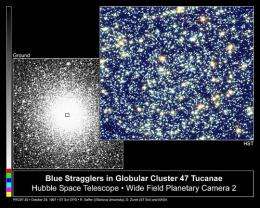Even stars get fat -- And 'stellar cannibalism' is the reason

Researchers have discovered evidence that blue stragglers in globular clusters, whose existence has long puzzled astronomers, are the result of 'stellar cannibalism' in binary stars. In other words, binary stars are eating each other and turning into a blue straggler.
The findings appear in the most recent issue of Nature, published today.
According to conventional theories, blue stragglers—massive rogue stars within globular clusters of about 100,000 stars—should have died long ago because all stars in a cluster are born at the same time. And yet the chubby blue stragglers, though they appear young, are found in virtually every observed cluster.
"We've known of these star abnormalities for 55 years now," says Alison Sills, associate professor in the Department of ������Ƶics & Astronomy at McMaster University. "Over time two main theories have emerged: that blue stragglers were created through collisions with other stars; or that one star in a binary system was 'reborn' by pulling matter off its companion."
Sills and her colleagues—Nathan Leigh, a PhD student in ������Ƶics & Astronomy at McMaster, and Christian Knigge, Reader in the School of ������Ƶics and Astronomy at Southampton University—looked at blue stragglers in more than 50 globular clusters. They found that the total number of blue stragglers in a given cluster did not correlate with the predicted collision rate—dispelling theory number one.
But more interestingly, they found a connection between the number of blue stragglers and the mass in the cluster's core, and hence the number of binary stars. This points to "stellar cannibalism" as the primary mechanism for forming blue stragglers.
"This is the strongest and most direct evidence to date that most blue stragglers, even those found in the cluster cores, are the offspring of two stars transferring matter," said Knigge. "In our future work we will want to determine whether the binary parents of blue stragglers evolve mostly in isolation, or whether dynamical encounters with other stars in the clusters are required somewhere along the line in order to explain our results."
This discovery comes as the world celebrates the International Year of Astronomy in 2009.
Source: McMaster University





















